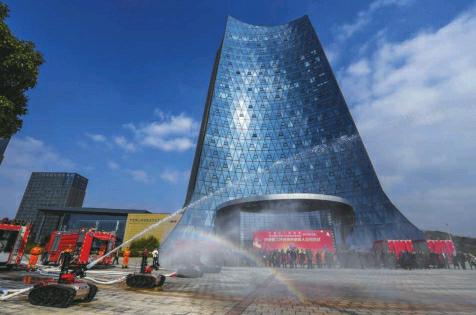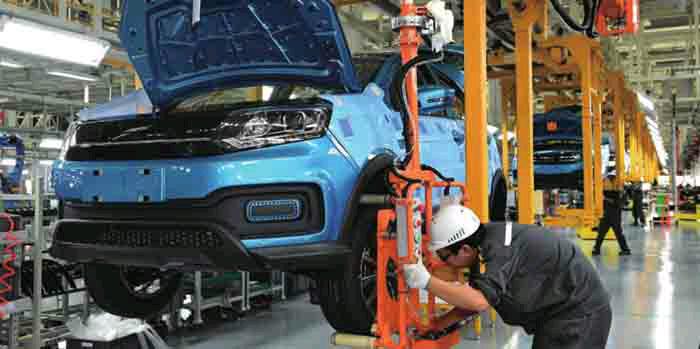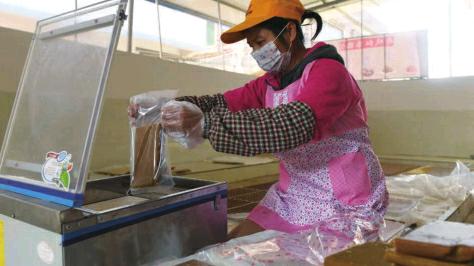Sing It Out Loud
2018-01-03
Performers from the China National Opera House sing at the opening ceremony of the third China Opera Festival in Nanjing, capital of east Chinas Jiangsu Province, on December 16. The opera festival kicked off on the same day, with 23 operas from across the country to be performed.
Crime Investigation
On December 19, Chinese authorities published a revised regulation on police investigations into economic crimes.
The revision was jointly issued by the Supreme Peoples Procuratorate (SPP) and the Ministry of Public Security to replace the earlier 2005 version.
Clarifi cations and guidance have been provided on topics such as police jurisdiction, registration of cases, use of compulsory measures, obtaining evidence and the disposal of relevant assets.
The revision highlighted the protection of human rights and property rights, with 15 of the 80 articles devoted to these matters.
Police have been urged to conduct their investigations with proper timing and methods so as to minimize interference in normal economic activities.
Procuratorate supervision of investigations has also been strengthened to avoid the potential abuse of power by the police.
The new regulations will take effect on January 1, 2018.
Online Drug Selling
The China Food and Drug Administration (CFDA) has issued a draft regulation on the supervision of the online drug business for public consultation.
The draft said that people who intend to run online drug businesses should fi rst report the necessary information to the local provincial food and drug department in order to receive certifi cation.
“Online drug operators should also guarantee the qualifi ed delivery of drugs bought online, set up a complaint system to protect consumer rights and keep records of adverse drug reactions,” it said.
The CFDA said it would establish a nationwide system for monitoring online drug operations and deal appropriately with any illegal conduct.
Traffic Safety
Chinas traffi c safety has improved in recent years with fewer serious road accidents and a good fl ight safety record, according to the countrys work safety and transportation authorities.
The number of serious road accidents, classifi ed as those that cause more than 10 deaths, has dropped to just 11 in 2016 from 55 in 2004, said a report jointly released on December 19 by the State Administration of Work Safety and the Ministry of Transport.endprint
Meanwhile, Chinas aviation industry has maintained 87 straight months of safe fl ights, the best air traffi c safety record in history, the report showed.
However, the report said road accidents were still frequent in China, with the annual death toll from road accidents the second highest in the world.
About 10 percent of Chinas road accident fatalities occurred on expressways, it said.
As of the end of 2016, the Chinese mainland had nearly 4.7 million kilometers of highways and 13.52 million trucks. In the fi rst 10 months of this year, Chinas highway freight volume reached 29.96 billion tons, according to the report.
Happy Workers
Almost 70 percent of Chinese employees aged 18 to 35 say they feel happy in their jobs, according to a survey by China Youth Daily on December 19.
The survey found that career happiness increased in people who had a higher education. More than 80 percent of those with a masters degree or above were happy at work, while only half of those without a high school education showed the same levels of satisfaction.
Over 60 percent of people unhappy in their job said that salary was the number one factor preventing happiness, followed by interpersonal relationships, and unclear career planning.
More than 50 percent of people suggested prioritizing personal interests in career choices as a means of increasing happiness.
“Universities and colleges should offer more career guidance and internships to help students learn what they want,” said Wang Hong, a member of China Career Development Mentor.
The survey questioned 1,983 people, over 75 percent of whom were in fi rst and second-tier cities.
Little Engineers
Contestants participate in the Future Engineer Project, an engineering competition for young people in Shanghai, on December 16. Over 10,000 students from primary and middle schools took part in this years edition of the annual competition.
Carbon Trading
On December 19, China unveiled a nationwide carbon emission trading system in a step toward establishing the worlds largest national carbon market.
The trading system is to be fi rst implemented in the power generation industry, according to the National Development and Reform Commission (NDRC), the countrys top economic planner.
Under the scheme, enterprises are assigned emission quotas and those producing in excess of their share of emissions are able to buy unused quotas on the market from those that cause less pollution.endprint
Since 2013, China has tested carbon trading in seven pilot cities including Beijing. Now the practice is to be expanded nationwide.
The power generation industry was chosen as the fi rst sector to enact the trading system due to its preparedness and the completeness of its data on emissions compared with other industries, said Zhang Yong, Deputy Head of the NDRC, at a press conference.
With more than 1,700 powergenerating fi rms included in the system, with total emissions exceed- ing 3 billion tons, the national carbon market in its fi rst phase will be bigger than any other market in the world, including that of the European Union, Zhang told reporters.
“We will consider including other energy and emission-intensive industries,” said Li Gao, an NDRC offi cial, who noted that the threshold for carbon trading may be reduced further.
Currently only companies with emissions equivalent to 26,000 tons of carbon dioxide or more can be involved in the trading system, according to Li.
He said carbon trading in the seven pilot cities saw transaction value reach 4.6 billion yuan ($696.8 million) as of November, with traded emission quotas exceeding 200 million tons.
By 2030, China aims to cut carbon dioxide emissions per unit of GDP by 60-65 percent from the 2005 level. Emissions fell 6.6 percent last year, surpassing the countrys goal of a 3.9-percent reduction, and dropped around 4 percent in the fi rst three quarters.
Robot Firefighters
Firefi ghting robots demonstrate their abilities at a delivery ceremony in the Meishan Free Trade Port Area of Ningbo, east Chinas Zhejiang Province. A total of 60 fi refi ghting robots were delivered on December 17.
Studying Overseas
More than 4.58 million Chinese students studied between 1978 and 2016, according to a report published on December 18.
Published by the Center for China and Globalization (CCG), a major Chinese think tank, the report said that 544,500 Chinese students studied abroad in 2016, up 3.97 percent from the previous year.
As of 2016, China was still a major source of international students studying in the United States, Canada, Australia, Japan, the Republic of Korea, and the United Kingdom, the report said.
It showed that over 31 percent of Chinese students chose to study business administration in 2016, a 4 percent increase compared with 2015, whilst 16 percent chose to study engineering, down 3 percent from the previous year.endprint
Meanwhile, the number of Chinese high school students studying in Canada accounted for more than half of the total international high school students in the country.
The report also showed that China has around 550 international schools, more than any other country.
In addition, China saw 11.3 percent growth in foreign student enrollments last year, with the number reaching 443,000, according to the report.
Pushing Forward Reform
China will further its supply-side structural reform in the coming year with more efforts to improve economic quality, according to a tonesetting economic meeting.
There will be a shift from “made in China” to “created in China,” said a statement released on December 20 after the annual Central Economic Work Conference. China will emphasize quality rather than speed while shifting its focus from quantity to quality in manufacturing.
Reforms on resource allocation will be pushed forward, with measures to eliminate ineffective supply, support innovative businesses and reduce cos ts in the real economy.
The need to deal with “zombie enterprises” was underscored to dissolve excess industrial capacity.
China will actively foster new growth drivers by promoting technological innovation, restructuring traditional sectors, helping businesses innovate and pressing ahead with military-civilian integration.
Business burdens will be relieved through fewer governmentimposed transaction costs and administrative charges. Energy and logistics expenditures will also be reduced by reforms in the power, oil and natural gas, and railway sectors.
Feeding the Green Economy
Technicians work in the assembly plant of a new energy car manufacturing company in Fuzhou, Fujian Province, on December 20.
In recent years, Fujian Province has been speeding up the development of its new energy automobile industry. So far, the province is home to eight manufacturers of new energy cars with annual production capacity totaling 150,000 units.
New Flight Path
Chinas national carrier, Air China, is expected to open the fi rst connecting fl ight between China and Panama in the coming year following months of groundwork laid by both sides, Chinese airport offi cials said on December 19.
According to Panama Citys Tocumen International Airport, Air China executives have met with Panamanian airport offi cials to discuss the specifi c issues.endprint
The fl ight is expected to be launched in March 2018, and includes a stopover in Houston in the U.S. state of Texas.
The carrier, with fl ights to 180 cities in 38 countries and regions, has confi rmed plans to open a regional offi ce in Panama.
The new fl ight was announced during Panamanian President Juan Carlos Varelas state visit to China from November 16 to 22, and is to operate twice a week.
Panama is a major transport hub in Latin America, with fl ights to 35 cities throughout Europe and the Americas.
Overseas Automobile Plant
Chinas JAC Motors has revealed plans to open its fi rst plant in Brazil with an investment of nearly 200 million reals ($61 million), the company said on December 18.
The plant, in the central state of Goias, near Brazils capital city Brasilia, will have a manufacturing capacity of up to 35,000 vehicles a year. The project is expected to take two years and provide around 820 new jobs.
The announcement was made after JAC Motors Brazil President Sergio Habib had presented the project during a meeting with Goias Governor Marconi Perillo.
JAC Motors expects a 40-percent growth in its vehicle sales in Brazil this year, far above average market growth of 11 percent.
Corn Planting Slashed
The area of land used for corn production in China is expected to be reduced by 1.33 million hectares in 2017 as the country seeks to address excessive stock, according to the Ministry of Agriculture (MOA).
The reductions are mainly concentrated in areas with low and irregular output, including the countrys arid northwest and desertifi ed regions in the southwest.
Years of fi scal support for corn farmers have left China with a substantial stockpile. In 2016, corn output stood at around 220 million tons, while stocks amounted to 230 million tons.
To balance the market, China has been pushing for agricultural reform since 2016, urging farmers to adjust their mix of crops to safeguard against blind expansion and focus on sustainable development, particularly in the corn industry.
While reducing corn output, China has been actively increasing the supply of crops that are in short supply, such as soybeans and potatoes.
Earlier this month, a committee from the MOA raised forecasts for corn output to 216 million tons in the 2017/18 crop year.
Forging Links
The inauguration ceremony of the joint China-Thailand high-speed railway project takes place in Pak Chong, Nakhon Ratchasima Province, Thailand, on December 21.endprint
The railways 253-km fi rst phase links Bangkok with Nakhon Ratchasima in northeast Thailand. Chinas share of the project includes design of the railway, supervision of its construction and manufacturing of trains and signal systems. Once completed, it will be Thailands fi rst high-speed railway, with trains operating at up to 250 km per hour. The planned second phase will run from Nakhon Ratchasima to Nong Khai on Thailands border with Laos, where it will connect with the China-Laos railway.
Gas Pricing Regulation Intensified
On December 19, the National Development and Reform Commission (NDRC) ordered local authorities to strengthen regulation on heating and natural gas prices during the upcoming holidays as demand is expected to surge.
The NDRC said in a statement that the heating prices for households that have converted from coal to gas for heating should be regulated more strictly during the New Year and Spring Festival.
Authorities should punish those who fabricate information on price hikes, engage in price rigging and fi xing, or make arbitrary charges for installing heating equipment, the NDRC said.
The move came amid surging natural gas demand in China as millions of households switched from coal to gas for heating this winter as part of nationwide efforts to help combat air pollution.
The countrys natural gas consumption rose 18.9 percent year on year in the January-November period, 12 percentage points higher than the fi rst half and more than 8 percentage points higher than the average growth in the previous fi ve years, according to NDRC data.
North Chinas Hebei Province has issued a second-level alert for natural gas supply, indicating that the provinces supply is 10 to 20 percent lower than its total demand.
Sweet Moment
A worker makes brown sugar in a workshop in Wuming District, Nanning, Guangxi Zhuang Autonomous Region, on December 19.
Wuming brown sugar is classifi ed as a part of the intangible cultural heritage in Nanning and a major source of income for local villagers.
Outbound Investment Regulated
The NDRC on December 18 issued guidelines for outbound private investment to address problems, such as irregular operations, which have emerged amid the accelerated global drive of domestic companies.
The new rules aim to guide offshore business operations, Meng Wei, spokesperson of the NDRC, said at a press conference.endprint
While acknowledging the contribution of private businesses to goods and technology exports as well as the Belt and Road Initiative, Meng said there were also side effects, citing blind decision-making, intense competition and the negligence of quality and safety.
To tackle the issues, the document was collectively compiled by agencies including the NDRC, the Ministry of Commerce and Peoples Bank of China, the countrys central bank.
“Private businesses should improve internal rules on decision making and fi nancial management in matters of overseas investment, and strengthen risk control by enacting safety measures and contingency plans,” according to the document.
Domestic and overseas procedures on investment should be followed and social responsibilities fulfi lled. Businesses should also comply with local environmental protection laws.
Meng said similar rules for stateowned enterprises are in the pipeline.
Cotton Output Rebounding
Chinas cotton output ended a fouryear negative streak, increasing 2.7 percent in 2017, as yield per hectare saw strong growth, offi cial data showed on December 18.
According to the National Bureau of Statistics (NBS), cotton output increased by 142,000 tons to around 5.49 million tons.
The total area of cotton fields in China fell 4.3 percent year on year to 3.23 million hectares, but yield per hectare rose 7.3 percent, the NBS said.
Northwest Chinas Xinjiang Uygur Autonomous Region, the countrys largest cotton-growing area, accounted for 74.4 percent of the total national output, 7.1 percentage points higher than last year.
Chinas cotton output peaked in 2012 at 6.84 million tons, more than 2.2 times that of 1978, before starting to drop from 2013 due to relatively low profi tability.
Though other cotton-growing areas continued to see shrinking output this year, Xinjiang posted increases in both area and yield, due to the promotion of scale production, according to Zhao Jianhua, an NBS statistician.endprint
